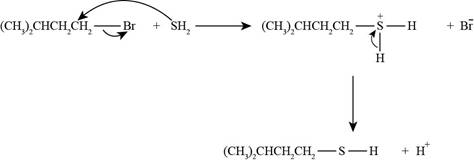
Concept explainers
(a)
Interpretation: The nucleophile needed to convert
Concept introduction: The replacement or substitution of one functional group with another different functional group in any
Answer to Problem 7.17P
The nucleophile needed to convert
Explanation of Solution
The reactant of the reaction is
![]()
Figure 1
The reaction of

Figure 2
The nucleophile needed to convert
(b)
Interpretation: The nucleophile needed to convert
Concept introduction: The replacement or substitution of one functional group with another different functional group in any chemical reaction is termed as substitution reaction. The electron rich chemical species that contains negative charge or lone pair of electrons are known as a nucleophile. In a nucleophilic substitution reaction, nucleophile takes the position of leaving group by attacking the electron deficient carbon atom.
Answer to Problem 7.17P
The nucleophile needed to convert
Explanation of Solution
The reactant of the reaction is
![]()
Figure 3
The reaction of

Figure 4
The nucleophile needed to convert
(c)
Interpretation: The nucleophile needed to convert
Concept introduction: The replacement or substitution of one functional group with another different functional group in any chemical reaction is termed as substitution reaction. The electron rich chemical species that contains negative charge or lone pair of electrons are known as a nucleophile. In a nucleophilic substitution reaction, nucleophile takes the position of leaving group by attacking the electron deficient carbon atom.
Answer to Problem 7.17P
The nucleophile needed to convert
Explanation of Solution
The reactant of the reaction is
![]()
Figure 5
The reaction of

Figure 6
The nucleophile needed to convert
(d)
Interpretation: The nucleophile needed to convert
Concept introduction: The replacement or substitution of one functional group with another different functional group in any chemical reaction is termed as substitution reaction. The electron rich chemical species that contains negative charge or lone pair of electrons are known as a nucleophile. In a nucleophilic substitution reaction, nucleophile takes the position of leaving group by attacking the electron deficient carbon atom.
Answer to Problem 7.17P
The nucleophile needed to convert
Explanation of Solution
The reactant of the reaction is
![]()
Figure 7
The nucleophile needed to convert
Want to see more full solutions like this?
Chapter 7 Solutions
Organic Chemistry
- Show how you might use the Williamson ether synthesis to prepare each ether. (a) (b)arrow_forwardDraw the products formed when A or B is treated with each reagent. In some cases, no reaction occurs.a. NaBH4, CH3OHb. [1] LiAlH4; [2] H2Oc. [1] CH3MgBr (excess); [2] H2Od. [1] C6H5Li (excess); [2] H2Oe. Na2Cr2O7, H2SO4, H2Oarrow_forwardWhat products are obtained from the reaction of the attached compound with one equivalent of Br2, using FeBr3 as a catalyst?arrow_forward
- What neutral nucleophile is needed to convert dihalide A to ticlopidine, an antiplatelet drug used to reduce the risk of strokes?arrow_forwardWhich reagent(s) would complete the reaction?arrow_forwardDraw a stepwise mechanism for the sulfonation of an alkyl benzene such as A to form a substituted benzenesulfonic acid B. Treatment of B with base forms a sodium salt C that can be used as a synthetic detergent to clean away dirt (see Problem 3.22).arrow_forward
- Draw a stepwise mechanism for the following Robinson annulation. This reaction was a key step in a synthesis of the steroid cortisone by R. B. Woodward and co-workers at Harvard University in 1951.arrow_forwardDevise a synthesis of each substituted cyclopropane. Use acetylene (HC=CH) as a starting material in part (a) and cyclohexanone as a starting material in part (b). You may use any other organic compounds and any needed reagents.arrow_forwardDraw the products of each reaction. (a) and (b)arrow_forward
 Organic Chemistry: A Guided InquiryChemistryISBN:9780618974122Author:Andrei StraumanisPublisher:Cengage Learning
Organic Chemistry: A Guided InquiryChemistryISBN:9780618974122Author:Andrei StraumanisPublisher:Cengage Learning Organic ChemistryChemistryISBN:9781305580350Author:William H. Brown, Brent L. Iverson, Eric Anslyn, Christopher S. FootePublisher:Cengage Learning
Organic ChemistryChemistryISBN:9781305580350Author:William H. Brown, Brent L. Iverson, Eric Anslyn, Christopher S. FootePublisher:Cengage Learning

